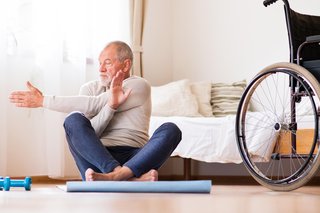A caption read: “Stunning exercises for disable. Our patient is shown by our fitness coach how to perform a series if stretching exercises for disable. It’s two words: “stunning exercise for disable” This caption doesn’t tell us what the exercises are or why we should learn them.
The viewer is not provided with any usage information other than the copyright information. This caption reads as follows: “These exercises to disable were created and edited by Dr. Ida Saarland from the University of Nijmeleen (The Netherlands). They are available for anyone who has permission to use the file in its entirety or part. (b) You must keep intact all the notices that appear on the download page and (c) You must include the following statement in your resource box: “Please visit Dr. Saarland’s website for more exercises for disable.”
The first caption reads
“Stunning exercises to disable”, while the second caption reads “Stunning exercises to disable.” These two captions may seem to contradict each other. They indicate that the same exercises will be presented, which can lead one to believe there are more than one. The seven in-wheelchair exercises should only be purchased for personal use. This disclaimer is intended to ensure that buyers don’t spend money on products that they are not suitable for personal use.

Commercial purposes according to the United States Copyright Office according to the current edition of the Fair Credit Reporting Act indicates that any product, including exercises for disable that are sold for a profit, must disclose the following information: (a) The name of the publisher, (b) The name of the author or creator of the work, and (c) A description of the work, including any source information. The Fair Credit Reporting Act further stipulates that all reports that include a “World Wide Web Page” must include a footer that identifies the site from which the report was taken. The Fair Credit Reporting Act also stipulates that publishers must comply with this requirement. Publishers can be fined $ 411.
Doctor doing stretching exercises for disability support providers at the right side of the body is a popular stock image by Jacob arabov. It is available in many resolutions: 1600×900 x900 x900 px, 1200×900 x900 px, and 1620×1080 pixels. The figure is surrounded by text. The caption says: “Exercises designed for disabled people.” The background shows a doctor’s room with yellow chairs and white walls.
The caption said that:
the “ema”, in the caption, meant “alone without companion or partner”. This means that an individual can do exercises for disabled with another person who is not a professional but who has the appropriate mobility to do the exercises. An individual who is not capable of performing the chair squatting test described in this article because of insufficient strength or the inability to maintain their balance can be paired with a non-ability disabled person who has the proper ability to perform the chair squatting test. This arrangement has the advantage that the non-ability handicapped person will be given the motivation and skills to learn how to properly do the chair squatting exercises from someone who is capable.
There are many commercial purposes according to the United States Copyright Office that require individuals to obtain a high resolution quality camera that is capable of taking photographs at various angles. One requirement is that the photographs are used for “some commercial purposes” according to the United States Copyright Law. If a person chooses to take the photos in a private capacity, they will be required to provide their own equipment. If they plan to sell the photos, however, they will need permission from the copyright owners if they want to use photos taken for commercial purposes.
When performing chair squat exercises for the visually impaired, it’s important to remember that the person should always look directly ahead while squatting. This will help them to avoid looking down and become trapped between two pieces of equipment. It is important that the person understands that adjustments may be necessary to ensure they are safe and correctly moving. A person could inflict serious bodily harm if they ignore any of these instructions.
